A trip to the Vancouver Aquarium Marine Science Centre will expose you to an amazing variety of marine animals and will allow you to assess and appreciate the knowedge you have earned by taking BIOL 205.
A trip to nearby Stanley Park will expose you to a somewhat limited, but still interesting, array of marine invertebrates living on the Vancouver Harbour foreshore. The following animals are likely to be seen (Note: all sizes given are for adult individuals):

Brockton Point, Stanley Park
Porifera
| Halichondria panicea |
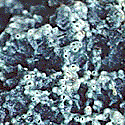 |
Yellow encrusting sponge. This view is of an open-coast
individual, that is green due to its photosynthetic zoochlorellae
symbiont. At Stanley Park, the species is more yellow in colour and
not so compressed in form.
Size: clumps 2 to 3 cm in height |
Cnidaria
| Obelia sp. |  |
Colonial hydroid. This genus exists in small bush-like growths, approximately 2 -4 cm in height, and can be found attached to rocks, seaweeds, barnacles, or other growth. |
| Urticina sp. |  |
Members of this genus may be found on the lower sides
of rocks in the low-intertidal zone. Specimens at Stanley Park are
likely to be small ones.
Size: to 20 cm in height |
Platyhelminthes
| Freemania litoricola |  |
This small brownish-coloured polyclad flatworm lives
on the undersides of rocks in the mid- to low-intertidal region. It
apparently feeds on barnacles.
Size: to 4 cm |
Nemertea
| Nemerteans |  |
One or two species of ribbon-worms may be seen amongst
the mussel and barnacle growth. Nemertines are carnivorous and possess
a highly extensible proboscis for attacking and engulfing a variety
of invertebrate prey.
Size: 30 -50 cm in length, highly variable |
Annelida
| Eudistylia polymorpha | 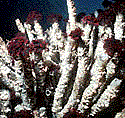 |
Tubeworm. For reason presumably of nutrient enrichment
of the Harbour water, this worm is one of the commonest residents
of the intertidal area at Brockton Point. It filter-feeds on organic
particles using its crown of branchial tentacles.
Size: 20 cm |
| Artonöe sp. | 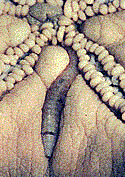 |
This and other scaleworms (polychaetes) such as Halosydna
sp. and Harmothöe sp. can be found living commensally with
the sea star Evasterias troschelii, or free-living, depending
on the species. It probably behaves more like a parasite than a true
commensal, although its main negative effects on its host are benign,
involving mostly the sharing of the host's meal.
Size: 2 - 3 cm |
| Nephtys sp. | 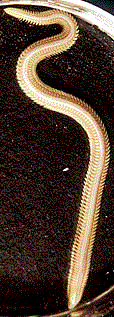 |
The sand-worm can be found under rocks in burrows in
the sand or amongst mussel clumps. It is carnivorous on other small
invertebrates, using its large pincer-like mandibles to subdue its
prey.
Size: 20 cm |
Mollusca
| Littorina scutulata | 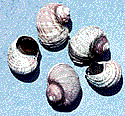 |
Shown here is L. sitikana. Littorrina scutulata
is usually smaller in size, more pointy-shaped, and has a reticulated
(checker-board) pattern on its shell. Both species live in the splash
zone at the top of the shore, where they feed on macro-algae and diatoms.
Size: 15 mm |
| Collisella digitalis |
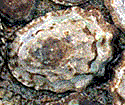 |
Lives in the high intertidal area on rocks. The distinctive
ribs on this algae-eating limpet help to identify it. Its diet is
mainly diatom coatings on the rocks and algal sporelings.
Size: 25 mm |
| Notoacmea scutum | 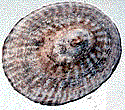 |
The dinner-plate limpet feeds on algae and diatoms and
is usually found in or around tidepools.
Size: 4 cm |
| Onchidoris bilamellata | 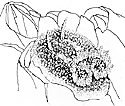 |
This nudibranch is found on and amongst barnacles, on
which it feeds.
Size: 2 cm |
| Mya arenaria |  |
The American soft-shell clam has a whitish or chalky-grey
coloured shell. It was introduced from the east coast of North America.
Size: 7 cm |
| Crassostrea gigas |  |
The Japanese oyster was introduced into the Ladysmith
area of Vancouver Island in 1912. It presently represents the mainstay
of the fairly lucrative B.C. oyster-culture industry.
Size: to 20 cm |
| Katharina tunicata |  |
The black-leather chiton feeds on diatoms and selected
macro-algae from mid-tide level to subtidal regions.
Size: 10 cm |
| Mytilus trossulus | 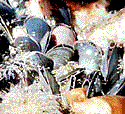 |
This mussel inhabits the mid-to low-intertidal area of
harbours, bays, and estuaries. It attaches to rocks with its many
byssus threads.
Size: 5 cm |
| Nucella lamellosa with egg cases | 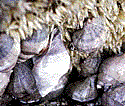 |
The common dog-whelk is making a comeback in the Stanley
Park region after being completely decimated in the mid-1970¹s by
an affliction known as imposex. All females in the population
turned to dysfunctional males, a response to a certain anti-fouling
paint used on boat hulls containing the metal tin (tributyltin).
Nucella is a predator on mussels and barnacles, drilling into
its prey with its radula.
Size: 5 cm |
Arthropoda
| Balanus glandula | 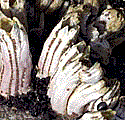 |
This is the largest barnacle in the intertidal area of
Stanley Park, reaching up to 1.5 cm in diameter. When crowded, individuals
become longer and possess weaker shells.
Size: 2 cm high |
| Chthamalus dalli | 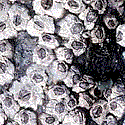 |
This is a much smaller barnacle than Balanus glandula.
It is brownish in colour and the four main covering plates form a
distinctive cross-shape when closed. Note in the photograph the poor
survival of many of the spat or juveniles.
Size: 5 mm dia |
| Hemigrapsus nudus |  |
This is one of two shore-crab species found in this region.
It is characterized by its reddish coloration and hairless legs. Both
Hemigrapsus species are omnivorous scavengers.
Size: 3 cm carapace width |
| Hemigrapsus oregensis |  |
Usually smaller than its congenor, H. nudus, is mottled
greyish-green in colour, has hairy legs, and lives in somewhat more
sedimenty conditions than does H. nudus.
Size: 25 mm carapace width |
| Cancer productus |  |
The red rock crab is the largest crab in the area, reaching
up to 15 cm in carapace width. It feeds mainly on bivalves and snails.
|
| Idotea wosnesenskii |  |
This distinctive olive green-coloured isopod can be found
on rocks and seaweed in the Fucus zone. It is herbivorous,
feeding on diatoms and small algae.
Size: 35 mm |
| Ligia pallasii | 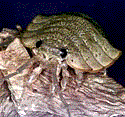 |
This slate-grey semiterrestrial isopod can occasionally
be seen on the seawall, above the high-tide level. It shuns immersion,
but is imperfectly adapted to life on land; hence, inhabits a narrow
vertical range of habitat extending only one or a few meters above
the tide-mark. It is mainly herbivorous, and favours diatoms and a
variety of macro-algae.
Size: 40 mm |
| Gnorosphaeroma oregonensis | This species is mottled-grey in colour, and is much smaller and pudgier than Idotea , or Ligia . It grows to about 1 cm in length, and is found more commonly in areas of freshwater seepage. It rolls up into a ball when disturbed. It is probably mainly a scavenger, but perhaps favouring plant matter. |
| Pagaris hirsutiusculus | this scavenging hermit crab is the commonest species of hermit crab to be found in the Stanley Park region. |
Echinodermata
| Strongylocentrotus droebachiensis | 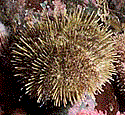 |
The green sea urchin is one of several related urchin
species found in B.C. waters. It eats mainly seaweeds.
Size: 8 cm test diameter |
| Pisaster ochraceus | 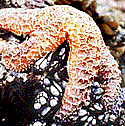 |
The common ochre star. Feeds on mussels and barnacles.
Size: 25 cm |
| Evastarias troschelli | 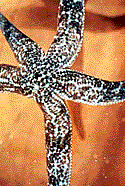 |
The mottled star is found in low intertidal regions where
it feeds on a variety of shelled and other invertebrates. This individual
is in the process of growing three new arms.
Size: 25 cm |
| Parastichopus
californicus with feces |
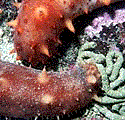 |
This brownish-coloured sea cucumber may be seen in the
lower region of the intertidal area. It is a scavenger of organic
matter, and eats a lot of sand and mud.
Size: to 40 cm in length |
| Pycnopodia heliathoides | 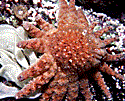 |
This, the world's largest-diameter seastar, is a fast-moving
predator of many invertebrates, including bivalves, sea urchins, chitions,
snails, hermit crabs, brachyuran crabs, worms, sea cucumbers, and
other sea stars. It also scavenges on dead animals.
Size: to1 m in diameter |
Equipment needed for the field trip:
- flashlight
- boots
- warm clothes
- come prepared for rain!